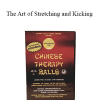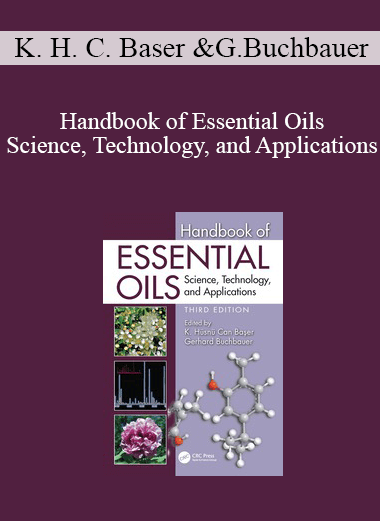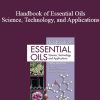K. Husnu Can Baser, Gerhard Buchbauer – Handbook of Essential Oils – Science, Technology, and Applications
$240.00 Original price was: $240.00.$54.00Current price is: $54.00.
Digital Download: You will receive a download link via your order email
Should you have any question, please contact us: [email protected]
Handbook of Essential Oils: Science, Technology, and Applications presents the development, use and marketing of essential oils. Exciting new topics include insecticidal applications, but there is a continued focus on the chemistry, pharmacology and biological activities of essential oils.
The third edition unveils new chapters including the insect repellent and insecticidal activities of essential oils, the synergistic activity with antibiotics against resistant microorganisms, essential oil applications in agriculture, plant-insect interactions, and pheromones and contaminants in essential oils.
Features
- Presents a wide range of topics including sources, production, analysis, storage, transport, chemistry, aromatherapy, pharmacology, toxicology, metabolism, technology, biotransformation, application, utilization, and trade
- Includes discussions of biological activity testing, results of antimicrobial and antioxidant tests, and penetration enhancing activities useful in drug delivery
- Covers up-to-date regulations and legislative procedures, together with the use of essential oils in perfumes, cosmetics, feed, food, beverages, and pharmaceutical industries
- Unveils new chapters including the insect repellent and insecticidal activities of essential oils, the synergistic activity with antibiotics against resistant microorganisms, essential oil applications in agriculture, plant-insect interactions, and pheromones and contaminants in essential oils
- The American Botanical Council (ABC) named the second edition as the recipient of the 2016 ABC James A. Duke Excellence in Botanical Literature Award and recognized that essential oils are one of the fastest growing segments of the herbal product market
Table of Contents
Chapter 1: Introduction
K. Hüsnü Can Başer and Gerhard Buchbauer
Chapter 2: History and Sources of Essential Oil Research
Karl-Heinz Kubeczka
Chapter 3: Sources of Essential Oils
Chlodwig Franz and Johannes Novak
Chapter 4: Natural Variability of Essential Oil Components
Eva Nemeth-Zambori
Chapter 5: Production of Essential Oils
Erich Schmidt
Chapter 6: Chemistry of Essential Oils
Charles Sell
Chapter 7: Analysis of Essential Oils
Adriana Arigo, Mariosimone Zoccali, Danilo Sciarrone, Peter Q. Tranchida, Paola Dugo and Luigi Mondello
Chapter 8: Use of Linear Retention Indices in GC/MS Libraries for Essential Oil Analysis
Emanuela Trovato, Giuseppe Micalizzi, Paola Duga, Margita Utczas, and Luigi Mondello
Chapter 9: Safety Evaluation of Essential Oils
Sean V. Taylor
Chapter 10: Metabolism of Terpenoids in Animal Models and Humans
Walter Jaeger and Martina Hoferl
Chapter 11: Central Nervous System Effects of Essential Oil Compounds
Elaine Elisabetsky and Domingos Savio Nunes
Chapter 12: Effects of Essential Oils on Human Cognition
Eva Heuberger
Chapter 13: Aromatherapy: An Overview and Global Perspectives
Rhiannon Lewis
Chapter 14: Essential Oils in Cancer Therapy
Carmen Trummer and Gerhard Buchbauer
Chapter 15: Antimicrobial Activity of Selected Essential Oils and Aroma Compounds against Airborne Microbes
Sabine Krist
Chapter 16: Quorum Sensing and Essential Oils
Isobel Charlotte Soede and Gerhard Buchbauer
Chapter 17: Functions of Essential Oils and Natural Volatiles in Plant-Insect Interactions
Robert A. Raguso
Chapter 18: Essential Oils as Lures for Invasive Ambrosia Beetles
Paul E. Kendra, Nurhayat Tabanca, Wayne S. Montgomery, Jerome Niogret, David Owens, and Daniel Carrillo
Chapter 19: Adverse Effects and Intoxication with Essential Oils
Rosa Lemmens-Gruber
Chapter 20: Adulteration of Essential Oils
Erich Schmidt and Jürgen Wanner
Chapter 21: Essential Oils and Volatiles in Bryophytes
Agnieczka Ludwiczuk and Yoshinori Asakawa
Chapter 22: Biotransformation of Monoterpenoids by Microorganisms, Insects, and Mammals
Yoshiaki Noma and Yoshinori Asakawa
Chapter 23: Biotransformation of Sesquiterpenoids, Ionones, Damascones, Adamantanes, and Aromatic Compounds by Green Algae, Fungi, and Mammals
Yoshinori Asakawa and Yoshiaki Noma
Chapter 24: Use of Essential Oils in Agriculture
Catherine Regnault-Roger, Susanne Hemetsberger, and Gerhard Buchbauer
Chapter 25: Essential Oils Used in Veterinary Medicine
K. Hüsnü Can Başer and Chlodwig Franz
Chapter 26: Encapsulation and Other Programmed/ Sustained Release Techniques for Essential Oils and Volatile Terpenes
Jan Karlsen
Chapter 27: Essential Oils as Carrier Oils
Romana Aichinger and Gerhard Buchbauer
Chapter 28: Influence of Light on Essential Oil Constituents
Marie-Christine Cudlik and Gerhard Buchbauer
Chapter 29: Influence of Air on Essential Oil Constituents
Darija Gajic and Gerhard Buchbauer
Chapter 30: The Essential Oil Trade
Hugo Bovill
Chapter 31: Industrial Uses of Essential Oils
W.S. Brud
Chapter 32: Storage, Labeling, and Transport of Essential Oils
Jens Jankowski, Jens-Achim Protzen, and Klaus-Dieter Protzen
Chapter 33: Recent EU Legislation on Flavors and Fragrances and Its Impact on Essential Oils
Jan C.R. Demyttenaere
Delivery Method
– After your purchase, you’ll see a View your orders link which goes to the Downloads page. Here, you can download all the files associated with your order.
– Downloads are available once your payment is confirmed, we’ll also send you a download notification email separate from any transaction notification emails you receive from IMC.sale.
– Since it is a digital copy, our suggestion is to download and save it to your hard drive. In case the link is broken for any reason, please contact us and we will resend the new download link.
– If you cannot find the download link, please don’t worry about that. We will update and notify you as soon as possible at 8:00 AM – 8:00 PM (UTC+8).
Thank You For Shopping With Us!





8 reviews for K. Husnu Can Baser, Gerhard Buchbauer – Handbook of Essential Oils – Science, Technology, and Applications
There are no reviews yet.